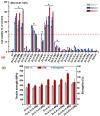Recent Developments in Zn-Based Biodegradable Materials for Biomedical Applications
- PMID: 36662048
- PMCID: PMC9865652
- DOI: 10.3390/jfb14010001
Recent Developments in Zn-Based Biodegradable Materials for Biomedical Applications
Abstract
Zn-based biodegradable alloys or composites have the potential to be developed to next-generation orthopedic implants as alternatives to conventional implants to avoid revision surgeries and to reduce biocompatibility issues. This review summarizes the current research status on Zn-based biodegradable materials. The biological function of Zn, design criteria for orthopedic implants, and corrosion behavior of biodegradable materials are briefly discussed. The performance of many novel zinc-based biodegradable materials is evaluated in terms of biodegradation, biocompatibility, and mechanical properties. Zn-based materials perform a significant role in bone metabolism and the growth of new cells and show medium degradation without the release of excessive hydrogen. The addition of alloying elements such as Mg, Zr, Mn, Ca, and Li into pure Zn enhances the mechanical properties of Zn alloys. Grain refinement by the application of post-processing techniques is effective for the development of many suitable Zn-based biodegradable materials.
Keywords: Zn alloys; biocompatibility; biodegradability; biodegradable materials.
Conflict of interest statement
The authors declare no conflict of interest.
Figures








References
-
- Li F., Li S., Liu Y., Zhang Z., Li Z. Current Advances in the Roles of Doped Bioactive Metal in Biodegradable Polymer Composite Scaffolds for Bone Repair: A Mini Review. Adv. Eng. Mater. 2022;24:2101510. doi: 10.1002/adem.202101510. - DOI
-
- Xing F., Li S., Yin D., Xie J., Rommens P.M., Xiang Z., Liu M., Ritz U. Recent Progress in Mg-Based Alloys as a Novel Bioabsorbable Biomaterials for Orthopedic Applications. J. Magnes. Alloy. 2022;10:1428–1456. doi: 10.1016/j.jma.2022.02.013. - DOI
-
- Unune D.R., Brown G.R., Reilly G.C. Thermal Based Surface Modification Techniques for Enhancing the Corrosion and Wear Resistance of Metallic Implants: A Review. Vacuum. 2022;203:111298. doi: 10.1016/j.vacuum.2022.111298. - DOI
-
- Wang J., Dou J., Wang Z., Hu C., Yu H., Chen C. Research Progress of Biodegradable Magnesium-Based Biomedical Materials: A Review. J. Alloys Compd. 2022;923:166377. doi: 10.1016/j.jallcom.2022.166377. - DOI
-
- Abraham A.M., Venkatesan S. A Review on Application of Biomaterials for Medical and Dental Implants. Proc. Inst. Mech. Eng. Part L J. Mater. Des. Appl. 2022:14644207221121981. doi: 10.1177/14644207221121981. - DOI
Publication types
LinkOut - more resources
Full Text Sources

